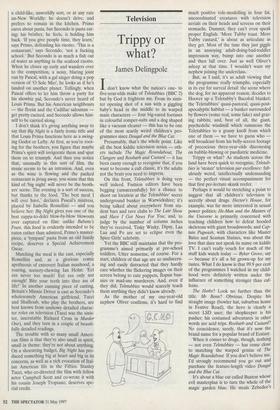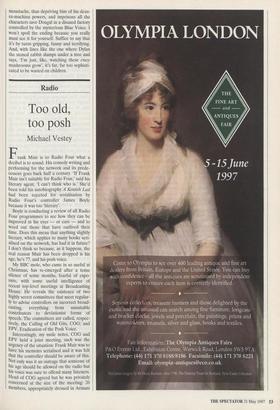Television
Trippy or what?
James Delingpole
Idon't know what the nation's one- to five-year-olds make of Teletubbies (BBC 2) but by God it frightens me. From its sinis- ter opening shot of a sun with a giggling baby's head in the middle to its warped main characters — four big-eared foetuses in colourful romper-suits and a dog shaped like a vacuum cleaner — this has to be one of the most scarily weird children's pro- grammes since Dougal and the Blue Cat.
Presumably, that's the whole point. Like all the best kiddie television series — oth- ers include The Magic Roundabout, The Clangers and Roobarb and Custard — it has been canny enough to recognise that, if you want to become a cult classic, it's the adults not the brats you need to impress.
On this front, Teletubbies is doing very well indeed. Fashion editors have been begging (unsuccessfully) for a chance to shoot on location at the Teletubbies' secret underground bunker in Warwickshire; it's being talked about everywhere from stu- dent bars and rave clubs to The Late Show and Have I Got News For You; and, to judge by the number of column inches they've received, Tinky Winky, Dipsy, Laa Laa and Po are set to eclipse even the Spice Girls' celebrity.
Yet the BBC still maintains that the pro- gramme's aimed primarily at pre-school toddlers. Utter nonsense, of course. For a start, children of that age are so undiscern- ing and easily distracted that they hardly care whether the flickering images on their screen belong to cute puppets, flopsie bun- nies or mad-axe murderers. And, even if they did, Teletubbies would scarcely teach them anything they didn't know already.
As the mother of my one-year-old nephew Oliver confirms, it's hard to find much positive role-modelling in four fat, uncoordinated creatures with television aerials on their heads and screens on their stomachs. Dammit, they can't even speak proper English. 'More Tubby toast. More Tubby custard,' is about as articulate as they get. Most of the time they just giggle in an annoying adult-doing-bad-toddler impression way, bump into one another and then fall over. Just as well Oliver's asleep at that time. I wouldn't want my nephew joining the underclass.
But, as I said, it's as adult viewing that the programme really triumphs, especially in its eye for surreal detail: the scene where the dog, for no apparent reason, decides to Hoover up a Teletubby's Bacofoil blanket; the Teletubbies' quasi-pastoral, quasi-post- apocalyptic habitat — a bunker surrounded by flowers (some real, some fake) and graz- ing rabbits; and, best of all, the giant, psychedelic windmill which summons the Teletubbies to a grassy knoll from which one of them — we have to guess who will broadcast from his belly-screen footage of precocious three-year-olds discoursing on bubble-blowing or paediatric medicine.
Trippy or what? As students across the land have been quick to recognise, Teletub- bies is 'stoner' television par excellence: fab- ulously weird, intellectually undemanding — the perfect visual accompaniment for that first pre-lecture skunk reefer.
Perhaps it would be stretching a point to suggest that all children's television is secretly about drugs. Hector's House, for example, was far more interested in sexual power politics; He-Man and the Masters of the Universe is primarily concerned with teaching children how to defeat hooded skeletons with giant broadswords; and Cap- tain Pugwash, with characters like Master Bates and Seaman Staines, was about the love that dare not speak its name on kiddie TV. I can't really vouch for much of the stuff kids watch today — Byker Grove, say — because it's all a bit grown-up for my tastes. What I do know is that 99.9 per cent of the programmes I watched in my child- hood were definitely written under the influence of something stronger than caf- feine.
The Herbs? Look no further than the title. Mr Benn? Obvious. Despite his straight image (bowler hat, suburban home in Festive Road), the hero is clearly a secret LSD user; the shopkeeper is his pusher; his costumed adventures in other words are acid trips. Roobarb and Custard? No coincidence, surely, that it's now the brand name for a popular brand of Ecstasy.
When it comes to drugs, though, nothing — not even Teletubbies — has come close to matching the warped genius of The Magic Roundabout. If you don't believe me, I'd strongly recommend you go out and purchase the feature-length video Dougal and the Blue Cat.
It's about a blue cat called Buxton whose evil masterplan is to turn the whole of the magic garden blue. He steals Zebedee's moustache, thus depriving him of his deus- ex-machina powers, and imprisons all the characters save Dougal in a disused factory controlled by the mysterious Blue Voice. I won't spoil the ending because you really must see it for yourself. Suffice to say that it's by turns gripping, funny and terrifying. And, with lines like the one where Dylan the stoned rabbit slumps under a tree and says, 'I'm just, like, watching these crazy mushrooms grow', it's far, far too sophisti- cated to be wasted on children.



































































 Previous page
Previous page